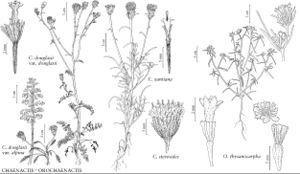Difference between revisions of "Chaenactis xantiana"
Proc. Amer. Acad. Arts 6: 545. 1865.
FNA>Volume Importer |
imported>Volume Importer |
||
| (6 intermediate revisions by 2 users not shown) | |||
| Line 8: | Line 8: | ||
}} | }} | ||
|common_names=Fleshy pincushion;fleshcolor pincushion;Xantus pincushion | |common_names=Fleshy pincushion;fleshcolor pincushion;Xantus pincushion | ||
| + | |special_status={{Treatment/ID/Special_status | ||
| + | |code=F | ||
| + | |label=Illustrated | ||
| + | }}{{Treatment/ID/Special_status | ||
| + | |code=E | ||
| + | |label=Endemic | ||
| + | }} | ||
|basionyms= | |basionyms= | ||
|synonyms= | |synonyms= | ||
| Line 32: | Line 39: | ||
-->{{#Taxon: | -->{{#Taxon: | ||
name=Chaenactis xantiana | name=Chaenactis xantiana | ||
| − | |||
|authority=A. Gray | |authority=A. Gray | ||
|rank=species | |rank=species | ||
| Line 46: | Line 52: | ||
|publication title=Proc. Amer. Acad. Arts | |publication title=Proc. Amer. Acad. Arts | ||
|publication year=1865 | |publication year=1865 | ||
| − | |special status= | + | |special status=Illustrated;Endemic |
| − | |source xml=https:// | + | |source xml=https://bitbucket.org/aafc-mbb/fna-data-curation/src/2e0870ddd59836b60bcf96646a41e87ea5a5943a/coarse_grained_fna_xml/V19-20-21/V21_1029.xml |
|tribe=Asteraceae tribe Heliantheae | |tribe=Asteraceae tribe Heliantheae | ||
|subtribe=Asteraceae (tribe Heliantheae) subtribe Chaenactidinae | |subtribe=Asteraceae (tribe Heliantheae) subtribe Chaenactidinae | ||
Latest revision as of 20:07, 5 November 2020
Plants 10–40 cm; proximal indument grayish, sparsely arachnoid, early glabrescent (usually glabrous by flowering). Stems mostly 1–5(–12); branches proximal and/or distal. Leaves basal (withering) and cauline, (1–)2–6 cm; largest blades linear or ± elliptic, ± plane or terete, ± succulent, 0–1-pinnately lobed; lobes 1–2(–5) pairs, remote, ± terete. Heads mostly 1–5(–7) per stem. Peduncles 1–5(–8) cm, glabrous (and ± expanded) distally. Involucres broadly obconic to campanulate. Phyllaries: longest 10–18 mm (surpassed by florets); outer distally tomentulose-puberulent in fruit (proximally glabrous, not stipitate-glandular), apices ± squarrose, blunt, pliant. Florets: corollas (diurnal) dirty-whitish to pinkish, 6–10 mm (± equal to cypsela lengths, anthers exserted); peripheral corollas erect to ascending, actinomorphic, scarcely enlarged. Cypselae 5–9 mm; pappi of 8 scales in 2, abruptly unequal series, longest scales 5–9 mm. 2n = 14.
Phenology: Flowering late Mar–Jul.
Habitat: Open, deep, loose sandy (rarely gravelly) soils, arid and semiarid shrublands, chaparral
Elevation: (100–)300–2500 m
Distribution

Ariz., Calif., Nev., Oreg.
Discussion
Selected References
None.
